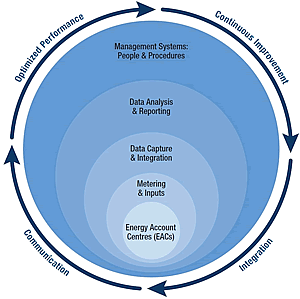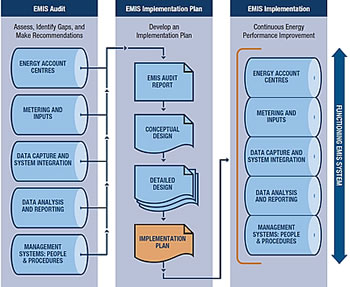Energy management information systems
An energy management information system (EMIS) is a performance management system that enables individuals and organizations to plan, make decisions and take effective actions to manage energy use and costs.
An EMIS makes energy performance visible to different levels of the organization by converting energy and utility driver data at energy account centres into energy performance information. It does this by using performance equations that are compared with the organization’s energy targets.
Figure 1 – EMIS performance management system

Figure 1
Text version
The EMIS performance management system is illustrated as a continuous cycle of communication, organized performance, continuous improvement and integration around a core that has Energy Account Centres (EACs) at its centre surrounded by the following consecutive layers: Metering & Inputs, Data Capture & Integration, Data Analysis and Reporting, and Management Systems: People and Procedures.
Implement an EMIS in your organization
There are three phases to developing an EMIS.
Figure 2 – Development of a functioning EMIS system

Figure 2
Text version
The development of a functioning EMIS system is illustrated in three phases. Phase 1 is the EMIS Audit to assess, identify gaps and make recommendations on the following separate elements: Energy Account Centres, Metering and Inputs, Data Capture and System Integration, Data Analysis and Reporting, Management Systems: People and Procedures. Phase 2 is to develop an EMIS Implementation Plan using an EMIS Audit Report, Conceptual Design and Detailed Design. Phase 3 is the EMIS Implementation with the aim of continuous energy performance improvement by unifying the elements identified in Phase 1.
Phase 1: EMIS Audit
An EMIS audit is an in-depth, eight-step process that will help your organization find out how much energy it is using, identify gaps and make recommendations. Critically, it will help you determine whether there is a financial case for implementing EMIS.
Use the sample worksheet (XLS, 348 KB) to help develop your business case.
Phase 2: Implementation Plan
This phase shows you accurate costs for implementing EMIS and details the scope of the project and the resources your organization needs to manage it. It also gives you a schedule to implement and manage an EMIS.
See the EMIS Planning Manual and Tool (ZIP, 5.61 MB) for instructions and tools to help develop your implementation plan.
Phase 3: Implementation
The implementation phase allows your organization to make continuous energy efficiency improvements. Once all aspects of your plan are implemented, your EMIS will
- gather information on energy consumption
- gather information on the useful outputs that result from the consumption of energy
- gather information on any other factors that may affect energy consumption
- contain analysis routines that allow you to compare between energy consumption and utility drivers
- build and display energy performance reports
For more information, read the guidebook for managers, engineers and operational staff called Energy Management Information Systems: Achieving Improved Energy Efficiency (PDF, 1.14 MB).
Page details
- Date modified: